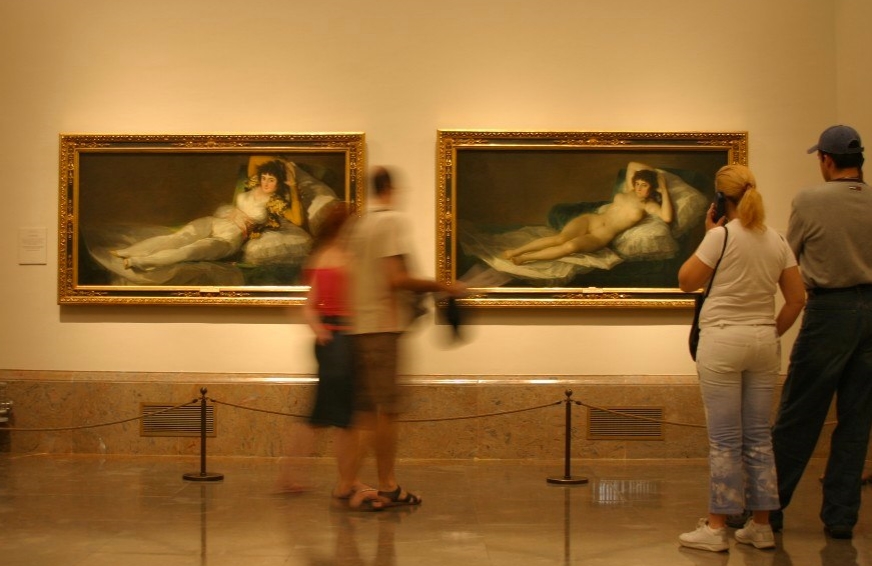It was in February 1975 that an officer of the municipal police in Cáceres, Piris by name, noticed that on show in the window of a bookshop in that Spanish city one could see, amid several other prints of works by the great Aragonese painter Goya, a copy of the painting popularly known as his Maja Desnuda, the ‘Nude Maja’. He did not hesitate for a moment; convinced that this was an assault upon morality and good behaviour, he entered the establishment to order its proprietor to withdraw the offensive item from public view, above all in order to prevent it exciting the libido of adolescent boys from a nearby school. At the time the news of his intervention aroused the sarcasm of the intellectual opposition (the only kind that then officially existed), who reacted almost joyfully, or at the least with amusement, because they saw in this bizarre incident an opportunity to show the world the ridiculousness of the last gasps of the censorship apparatus of the Franco dictatorship, which had only a few months left in which to sour the lives of Spaniards and which was then, like all the other elements of the regime, in a state of decay. The rest of Spain, or at least that part of it that had some awareness of the country’s situation, must have felt, when they heard of it, the same sensations that we feel now from the distance of today: a sense of pity and shame at one more unequivocal sign of the lack of culture and backwardness that, as a prevailing element in that society, had become a cause for pride for its ruling authorities (a full meeting of the city council of Cáceres asked the mayor to congratulate Piris for his meritorious action). A lamentable episode from a period that has fortunately been historically overcome, one might say.

La Maja Vestida (‘The Clothed Maja’) and La Maja Desnuda (‘The Nude Maja’), displayed side by side. Both by Francisco Goya (1746-1828). Source: Flickr
However, a few months ago thousands of signatures were gathered online for a petition to demand that the Metropolitan Museum of Art in New York withdraw from view a painting by Balthus, Thérèse Dreaming, because it was considered that this picture offers a complacently romantic image of voyeurism and the commodification of minors, one that is morally dangerous for the masses who might see it. The connotations are certainly different: in the case of the Maja Desnuda the censors came from the sinister camp of fascism (whose identification with evil cannot be doubted), while in the other the demand was based on the defence of victims of sexual abuse (which is, beyond all doubt, a good cause). Nevertheless, is it not legitimate to see a macabre similarity between both incidents, in the extent to which they appear to represent attempts to restrict civil liberties and impose an obligatory ideology (with all that this entails in terms of an attack upon the foundations of liberal societies)? Any response to this question has two dimensions, which are intimately interconnected: one refers to moral progress, and the other to aesthetic progress (can something be considered progress which 40 years ago was considered backwardness?). Let us try to go a little deeper into both.
On moral progress…
The concept of moral progress is problematic, above all because there exists a (false and fallacious) idea of it that has often made it possible to promote barbarism in its name: the idea that men of the present day are morally superior to our ancestors. This is a false concept because all the empirical evidence that anthropology has placed at our disposal suggests that all humans are made from the same moral base, and that we have the same defects and the same weaknesses in this regard. And it is a fallacious concept because the argument of moral superiority (of some eras over others, of some religions over others, of some races or classes over other races or classes, of oppressors over the oppressed or of the oppressed over their oppressors, of colonists over indigenous peoples or of indigenous peoples over colonists, and, in general, of ‘us’ over our enemies) has served at all times and in every part of the world to justify the worst atrocities, reducing ‘moral progress’ to victory (which is seen as a historical inevitability) of the superior over the inferior or, more concisely, of ourselves over the others. As Kant said, there is no way to resolve this question as long as it is presented as a war between incompatible moral systems.
On the contrary, the only admissible idea of moral progress is one that consists precisely of abandoning this interminable confrontation that, at the very beginnings of our culture (and also, indeed, in the creations of other cultures), the ancient Greek tragedies described as the bloody wheel of revenge, so perfectly dramatized in the Oresteia. It’s a wheel that only stops turning when this vicious circle is replaced by an acceptance, by all the contending parties, of a common law to whose justice they submit unconditionally. As Nietzsche explained in On the Genealogy of Morality, from the moment this happens, humanity abandons the jurisdiction of nature and enters into a previously-unknown ‘state of law’ that makes it possible for actions to be considered impersonally; justice has eyes only for the actions of the paedophile or the thief, but is blind to the personal identity of the authors of these actions, who are punished not for who they are but for what they have done. As a result, what Nietzsche called the ‘viewpoint of the injured party’ and with it the ‘senseless rage of resentment’ can be overcome. This does not mean that men subject to this law cease to feel, as private individuals, desire for vengeance for the offences they have suffered, but that – in order to avoid the damage that would be caused in the long term to their own civil liberties by giving free rein to the ‘right of revenge’ – they accept the legal proscription of such reactions for the benefit of the mechanisms of justice, thereby delegating to public authorities, as we say today, the monopoly of violence. According to this view, moral progress does not mean that some men may be morally superior to others but that some societies possess juridico-political institutions that are capable of protecting their members against human failings and frailties better than those of others.
With this as a basis it is possible to sustain significant moral advances that, if not totally irreversible, at least merit special legal protection. This happens, for example, when these advances are given constitutional status in order to make any possible reversion more difficult. We can point to some of the examples of significant progress from our own history, from the abolition of slavery to the institutionalization of civil liberties crystallized in the Universal Declaration of Human Rights and its subsequent ramifications: among others, the so-called ‘social contract’, the recognition of workers’ rights and everything we refer to today as social democracy, the emancipation of women from male tutelage, laws against racial discrimination or those for the protection of children, by virtue of the fact that all of them have been juridically ‘imprinted’ – albeit still in a deficient and unequal manner – into the legislation of the different states subject to the rule of law. However, as we have already observed, these advances do not represent points of no return in the moral evolution of humanity; that is, there is always a possibility that the progress represented by these institutions could be destroyed, and we could ‘regress’ to earlier, worse, situations.
…and moral regression
If one accepts what I have said so far in this article, any case of moral regression has to imply a degree of decadence in the mechanisms of justice I have mentioned, and a consequent tendency to reinstitute the polemical model of revenge and a struggle for moral superiority. From our recent history we can all recall the way in which Marxism questioned the concepts of law and essential rights in general (and civil liberties in particular), categorizing them as ‘ideological superstructures’ that camouflaged economic inequalities and reinforced class domination. It thus replaced the paradigm of law with one of war – the class struggle –, identifying justice with the victory of the oppressed over their oppressors. Given the enormous influence of Marxism, this discrediting of civil liberties was undoubtedly at the root of the gigantic fraud created around the communist states that has remained alive in propaganda terms until very recently, according to which the non-existence of these liberties in these states was not a defect but actually proof that within them there existed a state of ‘real’ freedom, not one that was merely ‘formal’ and deceptive like that experienced in liberal societies. A situation identical, at the same time, to the one sustained by other totalitarian states upon a doctrinal basis of racial superiority.
One might be led to think that today these propositions are as outmoded as the prejudices of Officer Piris, but in the years that have gone by since this grotesque period in history we have witnessed another form of ‘critique of law’ that, recycling some elements of the Marxist argument, has renewed it and prolonged its life into the present day in unequivocally contemporary and apparently ‘progressive’ form. One of its most striking incarnations was in the well-known theses of Michel Foucault, according to which the great political structures of modern society (the state, the parliament, government, the law courts, the free press, etc.) were only a superficial expression of an underlying correlation of forces in which a multiplicity of molecular, near-invisible ‘micro-powers’ (and ‘micro-desires’) struggle against each other, and it was these elements that constituted society’s deep structures and the source of its constant disquiet. Therefore, the supposed ‘impartiality of the law’ would in this theory again be a mere façade that concealed the asymmetrical characteristics of all power relationships.
The unquestionable success of these theories among many of the political movements that were born or reborn from the middle of the last century onwards, so much so that they have even had an impact on the political programmes of the parliamentary left and right, has no doubt benefited from another factor whose significance was surely not foreseen by Foucault: the ‘irresistible rise’ of identity conflicts as a platform for political action, which on so many occasions and in so many places has taken the place of the ‘class struggle’. As a result, today the majority of these ‘deep’ power conflicts have become struggles in which the underlying issue is not one of equality, as was the case with projects of the socialist variety, but the differences that constitute marks of identity for each of the adversaries, whose actions have ceased to be impersonal because justice has ceased to be blind to the individual identity of the antagonists. The judge feels a tug on his robe and is asked to ponder, not the quality of an action, but the identity of the actor. This new strategy entirely subverts what Nietzsche, in the passages quoted earlier, identified as the transition from a situation ‘of nature’, in which the harm done by one man to another is considered a matter between individuals, to one ‘of law’, in which the injury is understood as a violation of a law common to all and, therefore, as an offence against the collective as a whole. When this ‘collective as a whole’ disappears and implacably antagonistic identities are installed in its place, the contending parties cease to trust in justice (since their ‘difference’ does not allow itself to be reduced to equality before the law) and seek to recover the right of victims to vengeance, which does not pursue justice but rather the humiliation of the enemy and wishes, even when different arguments are used from those of totalitarian states, to correct all the errors of history in the light of their injured identity, including those in the history of art. We should note, for example, that the loss of confidence in the law courts as bodies capable of establishing (to the extent to which we mortals can ever establish such a thing, that is, in a manner that is always provisional and open to revision) the truth regarding social issues is also one of the unequivocal causes of the rise of so-called ‘post-truth’ (in other words, the possibility that each one of us can formulate some ‘alternative facts’ that suit our personal interests instead of trusting in truths that are publicly established).
On aesthetic progress (or regression)
This situation, which for the moment represents only a threatening shadow cast upon the rule of law, is combined together in the case we are concerned with here with the peculiar circumstances of the contemporary art we have inherited from the twentieth century. Although in this area too it would be absurd to speak of ‘aesthetic progress’ in a simplistic sense (that is, it would be absurd to maintain that the paintings of Rubens are better or worse than the frescoes of Michelangelo or Degas’ ballerinas) it is hard to deny that the artist, as a cultural producer, expresses an aspiration that was most constantly alive in his craft when the world of art set itself up, as it did in the nineteenth century, as a jurisdiction independent of the political, economic, religious or ‘moral’ authorities to which painters or musicians had been obliged to submit in earlier eras. From that point on one could demand that the production and evaluation of works of art should be carried out according to exclusively aesthetic criteria that did not require any legitimization from other spheres of judgement. Something very similar occurred with academic freedom or the freedom of the press, which, even though they may always have formed part of the ‘professional’ ideal of writers and teachers, could only be seen as truly guaranteed when their respective fields – scientific research, intellectual labour and the formation of public opinion – gained political autonomy from other social institutions that wished to instrumentalize them in the service of their own interests.
When Balthus painted Thérèse Dreaming, in 1938, artistic activity was still protected by that autonomous jurisdiction of which Officer Piris knew nothing, convinced as he was that he could legislate politically in the field of aesthetics in the name of a moral superiority that no one and nothing could resist. In fact, it was thanks to this protection that the artists who were persecuted by fascist and communist regimes for refusing to subject their aesthetic criteria to the political criteria of propaganda ministries were at least able to protest.
However, the work of the historic avant-garde, which was converted into a reference point for all contemporary art after the Second World War, consisted, among other things, precisely of a rejection and a blowing apart of this protection so that art could cease to be a sphere separate from life and become dissolved within it, nearly always by means of what Walter Benjamin called ‘the politicization of art’. Hence, at the same time as some have promoted ideas of the ‘microphysics of power’ and the ‘micropolitics of desire’, a significant section of modern artistic movements have abandoned what was left of the autonomous jurisdiction of modern aesthetics and sought a fundamentally political and moral legitimization for their works. Once again, we find ourselves before the same form of legitimization that the totalitarian regimes of the twentieth century had sought to give to the arts, the approach through which one could censor Goya’s Maja; once again, too, however, the political and moral causes at whose service some contemporary artists (symbolically) place themselves are unimpeachably ‘good’: they are on the side of victims of injustice, of discrimination, of the consequences of mass migration or of the effects of capitalism upon the planet. Nevertheless, whichever way one chooses to view this strategy in contemporary art (whether as ‘progress’ by comparison with its ‘autonomous’ past or as a regression to heteronomy) one thing is undeniable: from the moment when art slides towards a basis of legitimacy that is presented as more political and moral than aesthetic or merely artistic, it becomes virtually inevitable that it will be left defenceless against arguments that, like the proposal to censor Balthus’ painting, are based precisely upon the same moral and political reasoning and the same unimpeachable causes at whose service the work of the artist has been placed.
If to this we add the manner in which the new ‘politics of unease’ associated with identity wars have unleashed the ‘senseless rage of resentment’, there is every indication that, contrary to what we might have thought only a short time ago, the descendants of Officer Piris will still give us many more glorious moments to relate in the future.









